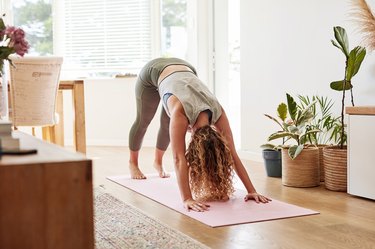
Choosing a style of yoga is a vibe. Should you go for something relaxing and meditative, or something more physically demanding? If you want to turn up the intensity of your flow, Ashtanga yoga might be what you're looking for.
Unlike Hatha yoga, Ashtanga is a more dynamic, fast-moving practice filled with synchronized poses, in which you link movement to breath. Because of its intensity, it can feel similar to a cardio workout rather than a gentle yoga class where you slowly transition from one pose to the next.
But don't let the intensity of Ashtanga dissuade you from trying it out. You'll still get many of the stress-reducing, restorative benefits of yoga. Whether you're new to yoga or a seasoned yogi, Ashtanga is a great practice to start if you're seeking a challenge.
Here's everything you need to know about Ashtanga yoga, including its basic principles and benefits, how to prepare for your first class and beginner poses to help you get started.
What Is Ashtanga Yoga?
Created by yoga guru Krishna Pattabhi Jois in 1948, Ashtanga yoga synchronizes breath and movement by inhaling while in the pose and exhaling as you transition to the next pose. By following this breathing technique, you're able to focus and get more out of the pose and your practice.
"Asthanga taught me how to breathe," says Christina Almeida, a San Antonio-based Ashtanga yoga instructor. "It has an essence of focus that goes beyond the strength of the body."
In Sanskrit, Ashtanga translates to "eight limb path" and refers to the eight limbs referenced in The Yoga Sutras of Pantanjali (the guidebook of yoga written by spiritual guide Sri Swami Satchidananda).
These eight limbs serve as guidelines for all yoga practitioners on how to live a purposeful and meaningful life:
- Yama (restraint)
- Niyama (observance)
- Asana (posture)
- Pranayama (breath control)
- Pratyahara (withdrawal of the senses from their objects)
- Dharana (concentration)
- Dhyana (meditation)
- Samadhi (contemplation)
Because yoga is, in many ways, a metaphor for leading a meaningful life (the patience of using your breath and the focus of deepening a pose), when you're practicing Ashtanga, you're training your body and mind to live by these eight limbs.
The Benefits of Ashtanga Yoga
While there isn't much research specifically around Ashtanga yoga and its benefits, there are some studies on yoga, in general, that show that it can help with preventing injury, reducing the risk of falls and managing pain. Not to mention, there are plenty of positive effects of practicing yoga on your mental health.
Although these studies are small, they show some promise that yoga can be beneficial as a complementary therapy for managing various health conditions and enhancing overall wellbeing.
It Can Build Balance
Because Ashtanga yoga is filled with arm-balance poses and inversions, you'll learn how to use your breath to balance and build the necessary strength to maintain good posture throughout the movements.
Yoga is linked to a lower risk of falls in older adults and people with neuromuscular issues, like multiple sclerosis and Alzheimer's disease, according to a January 2019 systematic review in the American Journal of Occupational Therapy.
Plus, earlier research published in June 2015 in PLOS One found that Ashtanga yoga helped enhance balance and postural stability in a small group of visually impaired adults.
It May Help Ease Lower-Back Pain
During an Ashtanga yoga class, you'll go through series of twists, backbends and binds, which can help improve your core strength and stability. By building better core stability, you'll put less pressure on your lower back. In fact, many of the exercises recommended for lower back pain, such as the plank, bird dog, cobra and cat-cow, are practiced in yoga.
A small pilot study published September 2019 in the International Journal of Yoga of people with chronic lower back pain found that practicing yoga at least twice a week helped with their discomfort.
It Enhances Flexibility and Range of Motion
The sun salutation in Ashtanga yoga, for instance, moves you from a standing position (Tadasana) to a forward fold and plank and push-up (Chaturanga). This sequence of poses not only enhances your range of motion but strengthens different muscle groups, like your arms, shoulders, back and core.
When 14 college athletes took two yoga sessions per week for 10 weeks as part of a small January 2016 International Journal of Yoga study, they improved their overall flexibility, range of motion and balance compared to other study participants who did no extra yoga.
"As an athlete, I was constantly working on achieving performance for the purpose of competition and winning ... my body only knew how to go hard," Almeida says. "I loved Ashtanga at first sight because it brought me back to the challenge of my athletic career with clarity of mind and yet, softness in body and control of my breath."
It Helps You Build Lean Muscle
While Ashtanga poses are all body-weight exercises, they train your muscles through weight-bearing balance movements. They also challenge your unilateral strength by working both sides of the body with binds and twists.
A December 2015 study in the Journal of Sports Science and Medicine enlisted 34 premenopausal people between the ages of of 35 and 50 to do eight months of Ashtanga yoga to examine the effects on bone turnover. Results showed that while Ashtanga didn't improve bone density, it did increase lean body mass. (However, so did regular physical activity among the women in the study's control group.)
It Can Lift Your Spirits
Nzingah Oniwosan, an Ashtanga yoga instructor based in Fort Lauderdale, Florida and founder of Yes Baby I Like It Raw, says Ashtanga yoga taught her how to embrace her flaws.
"I found my softness," Oniwosan says. "Which makes many laugh because Ashtanga is often seen as one of the most challenging practices, but in that practice, I learned how to rest and let go of my ego."
Various schools of yoga have been linked to lower feelings of anxiety and depression, according to a June 2017 review in the Journal of Evidence-Based Complementary Alternative Medicine. Plus, a September 2015 review in the Journal of Psychiatric Research found that yoga is tied to lower stress markers like blood pressure, heart rate and levels of the hormone cortisol.
Related Reading
What to Expect at Your First Ashtanga Yoga Class
There are two different types of Ashtanga classes: Ashtanga Led and Ashtanga Mysore. During Ashtanga Led classes, you'll move through three different sequences of poses known as the primary, intermediate and advanced series, which are led by an instructor.
Ashtanga Mysore, which is named after the Indian city where the Ashtanga practice originated, offers the same poses as Ashtanga Led classes. However, it's done at your own pace with more individual attention from the instructor.
Tip
“Start with an open mind and curiosity,” Almeida says. “There is so much to be learned from the physical practice of Ashtanga; however, there is so much more to be learned about the mental aspect. It is a process of falling in love with yourself, it is therapeutic and transforming.”
All About Ashtanga Mysore Classes
If you are new to Ashtanga yoga, Oniwosan recommends beginning with a Mysore class because you get more individual instruction on how to do the poses correctly.
For example, an instructor will give you specific cues and hands-on adjustments to achieve proper alignment in the poses and coach you on how to match your breath to your movement. Essentially, Ashtanga Mysore is a unique opportunity to work one-on-one with an instructor.
"In [an Ashtanga Mysore] class, you will get personal treatment and the teacher will give you poses based on where you are, and once you feel comfortable, new poses are added," Oniwosan says.
Ashtanga Mysore classes are progressive, so you'll finish each series of postures before moving on to the next. You'll do the same poses, typically starting with sun salutations, and add in new ones as you progress. If you learn through repetition, it offers a great way to perfect your form.
"When you go to a Mysore class, it will be nothing like you experienced before," Oniwosan says. "You will see people going into poses that may make you want to run or inspire you to commit to the practice."
Ashtanga Mysore is typically taught in two-hour time slots, where students can come and leave the studio (or sign off from an online class) whenever they'd like within those two hours. Whether you practice for the full two hours or just 30 minutes is up to you.
All About Ashtanga Led Classes
For more advanced yogis who are already familiar with the Ashtanga sequences and feel more comfortable doing the poses, Ashtanga Led classes are the way to go. Ashtanga Led classes help establish the pranayama breath control and the vinyasa count, which links the breath to movement.
Unlike Mysore, Ashtanga Led classes are roughly 90 minutes long and flow through three different series based on your level of the practice: primary, intermediate, and advanced.
- The Primary series (Yoga Chikitsa) consists of a beginning and finishing sequence. The beginning sequence includes sun salutations and standing postures, as well as seated postures, forward bends, twists and hip openers.
The finishing sequence includes poses like shoulderstand, Fish pose, headstand, Child's pose and Lotus pose with breathwork. These final poses are meant to help bring your heart rate down as you transition to Savasana (Corpse pose), which allows you to center your mind and reflect on your practice. - The Intermediate series (Nadi Shodhan) is made up of the same beginning poses as the primary series, but includes backbends, arm balances and inversions. It also has the same finishing sequence as the primary series.
- The Advanced series (Sthira Bhaga) includes hip openers, advanced arm balances and deep twists, binds and backbends.
How to Find an Ashtanga Yoga Class Near You
With Ashtanga yoga becoming more popular, there are many yoga studios across the country that offer it. Be sure to check out Yoga Alliance's teacher and yoga school directory, as well as ClassPass for local yoga studios that offer Ashtanga classes.
And if you belong to a big box gym, ask to see their yoga class offerings. There's a good chance they have an Ashtanga class or can recommend something similar.
If you're all about at-home workouts, there are many great resources for practicing online. Check out Yoga Greenbook, Alo Moves and Omstars.
A Beginner Ashtanga Yoga Flow to Try
Ready to take on Ashtanga yoga and experience the benefits for yourself? Here is Sun Salutation A of the Ashtanga primary series to help you get started.
Breathe through the poses and go at your own pace, safely moving from one pose to the next in the sequence. Repeat this sequence for 5 rounds, holding each pose for three to five breaths.
Move 1: Mountain Pose (Tadasana)
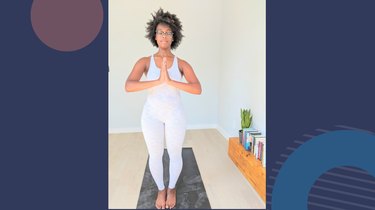
- Start standing with your big toes touching and a small amount of space between the heels.
- Ground down the four corners of your feet.
- Lengthen the crown of your head toward the ceiling.
Tip
In Tadasana, you have the option to have place your hands by your sides or in prayer in front of your chest.
Move 2: Upward Salute (Urdvha Hastasana)
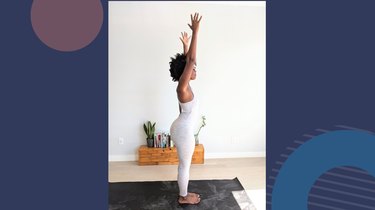
- From Mountain pose, turn your arms outward so your thumbs point backward.
- On an inhale, sweep your arms up toward the ceiling.
Tip
If you notice your shoulders hunching forward, roll them down and back.
Move 3: Standing Forward Fold (Uttanasana)
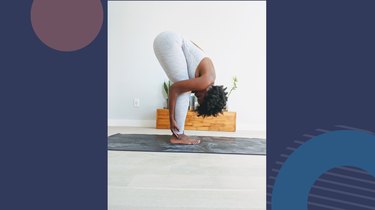
- From Upward Salute, place your hands on your hips, exhale and bend forward from the hip joints. Then, hold your ankles in each hand or wrap your arms around your calves.
- Press the heels firmly into the floor and lift the sitting bones toward the ceiling.
- With each inhale, lift and lengthen the front torso just slightly; with every exhale, release a little more fully into the forward bend.
- Let the crown of the head drop toward the earth.
Move 4: Standing Half Forward Bend (Ardha Uttanasana)
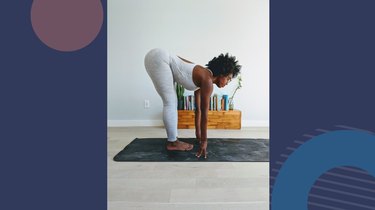
- From Standing Forward Fold, press your palms or fingertips into the floor or blocks on the floor beside your feet. If you don't have blocks, gently rest your hands on your shins.
- As you inhale, straighten your elbows and arch your torso away from your thighs, finding as much length between your pubic bone and navel as possible.
- As you push your palms (or fingertips) into your mat, draw your shoulders down and away from your neck and lift your chest up and away from the floor. It's OK to bend the knees slightly.
- Look forward, being particularly mindful about not compressing the back of your neck.
Move 5: Four-Limbed Staff Pose (Chaturanga Dandasana)

- From Standing Half Forward Bend, walk your feet to the back of your mat, landing in a high plank.
- Press your shoulder blades against your back ribs.
- As you exhale, slowly lower your body down halfway, hovering a few inches above the floor.
- Press the hands down into your mat, keep the elbows planted firmly by your sides and set your gaze slightly forward.
- On an exhale, transition into the next pose (or lie down on your mat if you need a breather or two!).
Tip
Be mindful of not allowing your lower back to sway toward the ground. If you notice this happening, shift your heels over your toes to align correctly and safely into this position.
Move 6: Upward Facing Dog (Urdhva Mukha Svanasana)
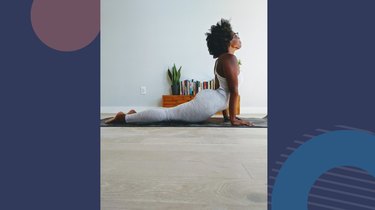
- From Four-Limbed Staff Pose, stretch your legs back with the tops of your feet on the floor.
- On an inhale, press your hands firmly into the floor, stacking your shoulders over the wrists.
- Straighten your arms and simultaneously lift your torso up and your legs a few inches off the floor. Keep the thighs firm and slightly turned inward and the arms firm and turned out so your elbow creases face forward.
- Open your heart in this pose, letting your chest shine through the space in front of you.
Move 7: Downward Facing Dog (Adho Mukha Svanasana)
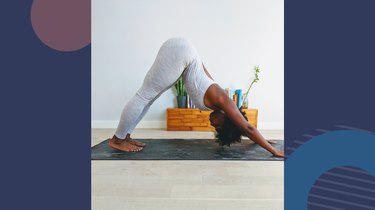
- From Upward Facing Dog, curl your toes under and push your sit bones up toward the ceiling.
- On an exhale, push your thighs back and stretch your heels down or toward your mat.
- Root down through the bases of the index fingers, pressing them actively into your mat.
- Draw the shoulders away from your ears and set your gaze at your navel. Avoid locking your knees in this pose; keep a slight bend in the knees if needed.
Move 8: Standing Half Forward Bend (Ardha Uttanasana)

- From Downward Facing Dog, walk your feet to the top of the mat behind your wrists.
- Press your palms or fingertips into the floor or blocks on the floor beside your feet. If you don't have blocks, gently rest your hands on your shins.
- As you inhale, straighten your elbows and arch your torso away from your thighs, finding as much length between your pubic bone and navel as possible.
- As you push your palms (or fingertips) into your mat, draw your shoulders down and away from your neck and lift your chest up and away from the floor. It's OK to bend the knees slightly.
- Look forward, being particularly mindful about not compressing the back of your neck.
Move 9: Standing Forward Fold (Uttanasana)
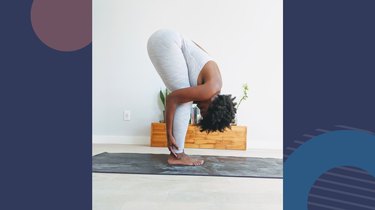
- From Standing Half Forward Bend, exhale as you release the hands from your mat and reach for your calves or the backs of your ankles.
- Stack your hips over your ankles.
- As you lift the sitting bones toward the ceiling, let the upper body hang heavy here. Reach for opposite elbows if you want to stay in this pose for a few more breaths.
- With each inhale, lift and lengthen the front torso just slightly; with every exhale release a little more fully into the forward bend.
Move 10: Upward Salute (Urdvha Hastasana)
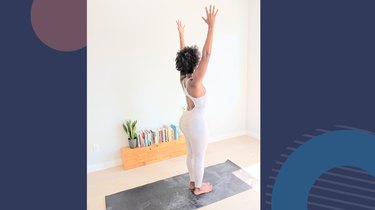
- From Standing Forward Fold, slowly bring your body all the way up to stand in Mountain pose.
- Turn your arms outward so your thumbs point backward.
- With an inhale, sweep your arms up toward the ceiling,
Move 11: Mountain (Tadasana)
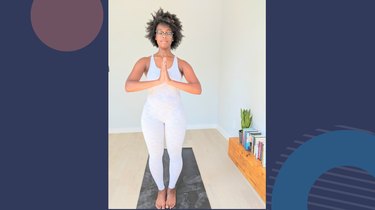
- From Upward Salute, bring your arms down to your sides or to prayer in front of your chest.
- Stand with your big toes touching and a small amount of space between your heels.
- Lengthen the crown of your head toward the ceiling.
- Close your eyes or set your gaze directly in front of you.